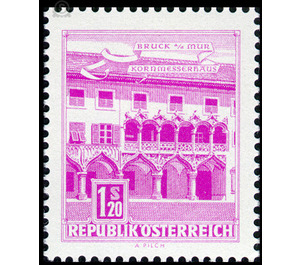Structures - Austria / II. Republic of Austria 1962 - 1.20 Shilling
Theme: Architecture
| Country | Austria / II. Republic of Austria |
| Issue Date | 1962 |
| Face Value | 1.20 |
| Color | violet |
| Printing Type | offset |
| Stamp Type | Definitive |
| Item Type | Stamp |
| Chronological Issue Number | 459 |
| Chronological Chapter | OOS-OE2 |
| SID | 911525 |
| In 87 Wishlists | |
The settlement area around Bruck a. d. Mur was already inhabited by people in the Paleolithic. The Romans recognized the important function of the Mur-Mürz junction as a traffic hub and built there the settlement Poedicum. Here the road, coming from Vindobona, crossed Carinthia into the Roman settlement area. Przemysl Ottokar II built at the present place between Mur and Mürz in 1263 a city. The name Bruck appears in a document from 860 for the first time, when King Ludwig the German gave the archbishop of Salzburg, among other things, a farm "Ad Pruccam". Bruck could therefore look back in 1960 on its detectable 1100th anniversary and celebrated in 1962/63 the anniversary of the founding of the city 700 years ago. Due to its historical development, the city has a number of attractions, the most famous of which is the Kornmesserhaus, a gothic profane building. It was built in the years 1499 to 1505 for the Brucker citizen Pankraz Kornmess. The Kornmesserhaus is an expression of the economic heyday of the city of Bruck a. d. Mur and witness to the wealth of the bourgeoisie in the time of Emperor Maximilian (1493 to 1519). It can be described as the most beautiful late Gothic townhouse in Austria.


